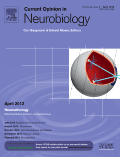
CURRENT OPINION IN NEUROBIOLOGY
Scope & Guideline
Uncovering Trends and Transformations in Neurobiology
Introduction
Aims and Scopes
- Neurodevelopment and Plasticity:
Research on the mechanisms of neural development, including cellular and molecular processes that guide neurogenesis, synapse formation, and circuit maturation. - Neurodegenerative Disorders:
Exploration of molecular and cellular mechanisms underlying neurodegenerative diseases such as Alzheimer's, Parkinson's, and schizophrenia, with a focus on potential therapeutic targets and interventions. - Behavioral Neuroscience:
Investigating the neural circuits and mechanisms that underpin behavior, cognition, and emotion, including studies on decision-making, addiction, and social behaviors. - Neuroimmunology:
Examining the interactions between the nervous system and the immune system, including the role of neuroinflammation in health and disease. - Computational Neuroscience and Modeling:
Utilization of computational models to understand neural dynamics, circuit function, and the integration of sensory information, with applications in both basic and applied neuroscience. - Ethology and Natural Behavior:
Studying the neural basis of natural behaviors across species, emphasizing the evolutionary context and ecological relevance of neural functions. - Stem Cell and Regenerative Neuroscience:
Research on the application of stem cell technologies to understand neural development and potential regenerative therapies for CNS injuries and diseases.
Trending and Emerging
- Interdisciplinary Approaches:
An increasing number of publications are integrating methods from various fields, including genetics, computational biology, and artificial intelligence, to address complex neurobiological questions. - Neuroinflammation and Immune Interactions:
There is a growing focus on the role of neuroinflammation and the interactions between the nervous and immune systems, particularly in the context of neurodegenerative diseases and mental health disorders. - Ethological and Naturalistic Studies:
Research emphasizing the study of naturalistic behaviors and ethological approaches is on the rise, reflecting a shift towards understanding behavior in ecological and evolutionary contexts. - Advancements in Neurotechnology:
Emerging technologies, such as optogenetics, advanced imaging techniques, and CRISPR-based methods, are increasingly being applied to explore neural circuits and their functions. - Focus on Sex Differences in Neuroscience:
There is a notable increase in research addressing sex differences in neural function and behavior, highlighting the importance of considering biological sex in neurobiological studies. - Machine Learning and Data-Driven Approaches:
The application of machine learning and data-driven methodologies to analyze neural data and model brain functions is becoming more prevalent, offering new insights into neural computation and behavior.
Declining or Waning
- Basic Neurophysiology:
While fundamental neurophysiological studies remain important, there has been a noticeable decline in papers focused solely on traditional neurophysiological methods without integrating more complex behavioral or computational approaches. - Historical Perspectives on Neurobiology:
Research articles that provide purely historical insights into neurobiology, without linking to contemporary issues or advancements, are becoming less common as the field trends toward more applied and interdisciplinary research. - Isolation of Neural Structures:
The focus on studying isolated neural structures or circuits in a reductionist manner is waning, as there is a growing emphasis on understanding neural networks and systems-level interactions. - Neuropharmacology of Traditional Drugs:
Research centered exclusively on the neuropharmacological effects of traditional drugs is decreasing, with a shift towards understanding polypharmacy and the impact of new therapeutic agents in complex disease models. - Single-Species Models:
There is a decline in studies using single-species models in favor of comparative approaches that consider multiple species to understand neural function and behavior in an evolutionary context.
Similar Journals

CEREBRAL CORTEX
Elevating the discourse in neuroscience research.CEREBRAL CORTEX, published by Oxford University Press Inc, is a premier journal dedicated to advancing the field of neuroscience, specifically focusing on the cellular, molecular, and cognitive aspects of cortical structure and function. With an impressive impact factor that situates it in the top quartile (Q1) of its categories for 2023, this journal holds significant relevance for researchers and professionals interested in the latest discoveries and methodologies in both Cognitive Neuroscience (ranked #31 out of 115) and Cellular and Molecular Neuroscience (ranked #48 out of 97). Operating without an open access model, it ensures rigorous peer review and dissemination of high-quality research from across the globe. Since its inception in 1991, CEREBRAL CORTEX has established itself as a critical platform for educators and inventors, pushing the boundaries of knowledge in understanding brain function and its implications for behavior. Researchers and students alike will find this journal an invaluable resource for both foundational and cutting-edge studies in neuroscience.

Neural Development
Elevating Understanding of Neural Processes WorldwideNeural Development, published by BMC, is a premier open access journal dedicated to advancing the field of Developmental Neuroscience. Established in 2006, this journal continues to foster high-caliber research on the cellular and molecular mechanisms underlying neural development, contributing significantly to our understanding of brain structure and function. With a commendable Q1 ranking in the 2023 category of Developmental Neuroscience and a notable position as the 8th out of 37 journals in the field on Scopus, it is recognized for its rigorous peer-review process and impactful publications. Researchers, professionals, and students benefit from the widespread accessibility of its content in an evolving landscape of neuroscience studies. As an open-access journal, Neural Development ensures that groundbreaking discoveries are available to a global audience, facilitating collaboration and innovation in the exploration of neural mechanisms. With its strong commitment to quality and relevance, this journal remains at the forefront of developmental neuroscience research.

NATURE REVIEWS NEUROSCIENCE
Empowering researchers through comprehensive reviews.NATURE REVIEWS NEUROSCIENCE is a prestigious journal published by NATURE PORTFOLIO, renowned for its commitment to advancing the field of neuroscience. Since its inception in 2000, it has become a significant platform for disseminating comprehensive reviews and insights that shape the understanding of neurological science. With an impressive Scopus ranking of #2 out of 113 in the General Neuroscience category, this journal consistently engages the top 2% of researchers and professionals in the field, underscoring its impactful contributions. The journal not only provides a forum for high-quality reviews but also bridges emerging research trends with established knowledge, fostering a robust discourse among scholars and practitioners. As a Q1 journal in Neuroscience (miscellaneous), NATURE REVIEWS NEUROSCIENCE offers invaluable access to critical research developments, making it an essential resource for students, researchers, and professionals aiming to stay at the forefront of neuroscience advancements. Explore the latest findings and engage with a global community dedicated to unraveling the complexities of the nervous system.

Neuroscience Bulletin
Exploring the intricate pathways of the mind.Neuroscience Bulletin is a prestigious academic journal published by SPRINGER, focusing on the dynamic and interdisciplinary field of neuroscience. Established in 2005, this journal has consistently provided a platform for groundbreaking research, showcasing contributions that span various aspects of neuroscience, physiology, and medicine. With an admirable impact factor and recognition as a Q1 journal in both Medicine and Neuroscience categories for 2023, it ranks highly in the Scopus metrics, reflecting its importance in advancing scientific knowledge and practice. Researchers and professionals alike benefit from its cutting-edge articles, which are accessible through traditional subscription models. The Neuroscience Bulletin plays a crucial role in disseminating significant findings and fostering collaboration within the global research community, making it an essential resource for anyone engaged in the exploration of neural mechanisms, treatments, and innovations.

Frontiers in Neural Circuits
Unlocking the Mysteries of the Brain's PathwaysFrontiers in Neural Circuits is a leading open-access journal dedicated to the rapidly advancing field of neuroscience, published by FRONTIERS MEDIA SA in Switzerland. Established in 2007, the journal has made significant strides in disseminating cutting-edge research through its commitment to open access, ensuring that groundbreaking discoveries are freely available to researchers, professionals, and students worldwide. With an impressive reputation, it occupies Q1 status across multiple categories, including Cellular and Molecular Neuroscience and Cognitive Neuroscience, reflecting its impact in these areas. Furthermore, its notable rankings within Scopus place it among the top journals, emphasizing its importance and influence, particularly in the domains of Sensory Systems and Neuroscience as a whole. By focusing on new findings related to neural circuitry and its implications for cognitive processes, Frontiers in Neural Circuits serves as an essential resource for anyone vested in advancing knowledge and understanding in the intricate field of neuroscience.

Experimental Neurobiology
Exploring the Complexities of the Nervous SystemExperimental Neurobiology is a prominent academic journal published by the Korean Society for Brain and Neural Science and the Korean Society for Neurodegenerative Disease, dedicated to advancing the field of neurobiology. With an ISSN of 1226-2560 and an E-ISSN of 2093-8144, this journal plays a pivotal role in disseminating innovative research findings from 2015 to 2024. The journal has established its relevance within the scientific community, achieving a Q3 ranking in Cellular and Molecular Neuroscience and a Q2 ranking in Neurology (Clinical) as of 2023. Researchers exploring the complexities of neurobiology will find a platform for their findings, as it currently holds a rank of #182 in clinical neurology and #73 in cellular and molecular neuroscience within the Scopus database. Although open access is not presently available, the journal remains committed to academic excellence and provides a critical resource for those engaged in the study of neurological diseases and mechanisms.

TRENDS IN NEUROSCIENCES
Connecting Ideas Across the Neuroscience SpectrumTRENDS IN NEUROSCIENCES, published by CELL PRESS, is a leading journal in the field of neuroscience, offering cutting-edge insights and important developments in the rapidly evolving landscape of brain research. With an impressive Impact Factor and ranking in the top quartile (Q1) of the category for Neuroscience (miscellaneous), it is positioned as a vital resource for researchers and professionals seeking to stay abreast of the latest discoveries and trends from 1978 to the present. Specifically ranked #3 out of 113 in General Neuroscience by Scopus, this journal promotes the interdisciplinary exchange of ideas and knowledge, making it an essential platform for students and experienced scholars alike. Although it is not an Open Access journal, its value lies in its rigorous peer-review process and commitment to maintaining the highest standards of academic integrity. By continuing to explore the complexities of neural processes and behavior, TRENDS IN NEUROSCIENCES plays a crucial role in shaping the future of neuroscience research and education.

CORTEX
Pioneering Research in Psychology and NeurologyCORTEX is a premier international journal published by Elsevier Masson, focusing on the cutting-edge areas of cognitive neuroscience, psychology, and neurology. With an impressive impact factor that places it in Q1 quartiles across multiple categories such as Cognitive Neuroscience and Neuropsychology, this journal serves as a vital resource for researchers, clinicians, and students alike. Established in 1964, CORTEX has continued to excel in disseminating high-quality scholarly work, offering insights that significantly enhance our understanding of the brain's functioning and behavior. Although not an open-access publication, it provides various access options to ensure the dissemination of knowledge is as wide-reaching as possible. As the field of cognitive psychology evolves, CORTEX remains at the forefront, fostering an environment for interdisciplinary collaboration and innovation. Researchers seeking to stay engaged with the latest advancements will find CORTEX an indispensable tool for their professional development.

JOURNAL OF COMPARATIVE NEUROLOGY
Diving Deep into Neurophysiological ComparisonsThe Journal of Comparative Neurology, published by Wiley, stands as a cornerstone in the field of neuroscience since its inception in 1911. With an ISSN of 0021-9967 and an E-ISSN of 1096-9861, this esteemed journal spans a comprehensive scope of comparative neuroanatomy, neurophysiology, and neural development, providing critical insights into the intricate workings of nervous systems across species. The journal has earned a prestigious Q2 ranking in the category of general neuroscience for 2023, showcasing its substantial impact, reflected in its Scopus ranking of #47 out of 113 journals in its field. Researchers and professionals examining evolutionary patterns, neural structure functions, and comparative studies will find this journal an invaluable resource. Although it does not provide open access, its rigorous peer-review process ensures the publication of high-quality research that is crucial for advancing knowledge in comparative neurobiology. With a commitment to fostering scholarly exchange, the Journal of Comparative Neurology remains dedicated to exploring the complexities of the nervous system through a comparative lens, making it a vital platform for the global neuroscience community.

NEUROREPORT
Fostering excellence in neuroscience research since 1990.NEUROREPORT is a distinguished journal in the field of neuroscience, published by Lippincott Williams & Wilkins. With an ISSN of 0959-4965 and an E-ISSN of 1473-558X, the journal has established itself as a vital platform for disseminating innovative research and developments in the dynamic area of neuroscience since its inception in 1990. Currently, it is positioned in the Q3 category of the 2023 Journal Rankings, reflecting its respectable standing within the community of neuroscience professionals, ranked #74 out of 113 in general neuroscience on Scopus, placing it in the 34th percentile. While it operates on a traditional subscription model, NEUROREPORT is committed to fostering knowledge sharing in the realm of neurobiology, neuropharmacology, and cognitive studies among researchers, professionals, and students alike. With its broad scope and commitment to scientific excellence, the journal continues to be a cornerstone for those seeking to stay ahead in the evolving landscape of neurological research.